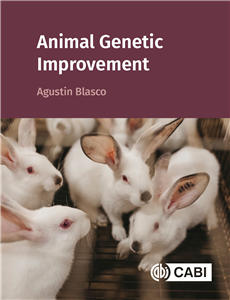The Genetics and Genomics of the Rabbit
by Luca Fontanesi
Rabbits have many uses - as well as being cherished pets, they are bred for their meat and fur, and as laboratory animals. Understanding their genetics and genomics is key to their production and, equally, to their care, welfare and health. Beginning with an introduction to the rabbit, including key information on their evolution, domestication and breed types, this book then concentrates on the genetics and genomics of this valuable animal.This book covers:- Cytogenetics, genetic maps and QTL mapping;- Immunogenetics;- Genetics of coat colour, meat, fibre and fur production, reproduction, disease resistance and more.Concluding with practical applications such as creating transgenic and genome edited rabbits, biotechnical applications and the rabbit as a biomedical model, this book brings this important topic fully up-to-date. It provides an indispensable resource for animal and veterinary researchers and students, as well as rabbit breeders and laboratory scientists. Chapter 1: The Evolution, Domestication and World Distribution of the European Rabbit (Oryctolagus cuniculus) Chapter 2: Rabbit Breeds and Lines and Genetic Resources Chapter 3: The Genome of the European Rabbit and Genomic Tools Chapter 4: Cytogenetics, Physical and Genetic Maps and QTL Mapping in the European Rabbit Chapter 5: Immunogenetics in the Rabbit Chapter 6: Genetics and Molecular Genetics of Coat Colour in the European Rabbit Chapter 7: Genetics of Fibre and Fur Production in Rabbits Chapter 8: Genetics and Molecular Genetics of Morphological and Physiological Traits and Inherited Disorders in the European Rabbit Chapter 9: Genetics of Disease Resistance in the European Rabbit Chapter 10: Genetics and Genomics of Growth, Carcass and Meat Production Traits in Rabbits Chapter 11: Biology of Reproduction and Reproduction Technologies in the Rabbit Chapter 12: Genetics of Reproduction in the Rabbit Chapter 13: Genetic Improvement in the Meat Rabbit Chapter 14: Rabbit Research in the Post-genomic Era: Transcriptome, Proteome and Metabolome Analyses Chapter 15: Methods to Create Transgenic and Genome-edited Rabbits Chapter 16: Pluripotent Stem Cells in Rabbits Chapter 17: Biotechnology Applications in the Rabbit Chapter 18: The Rabbit as a Biomedical Model
























